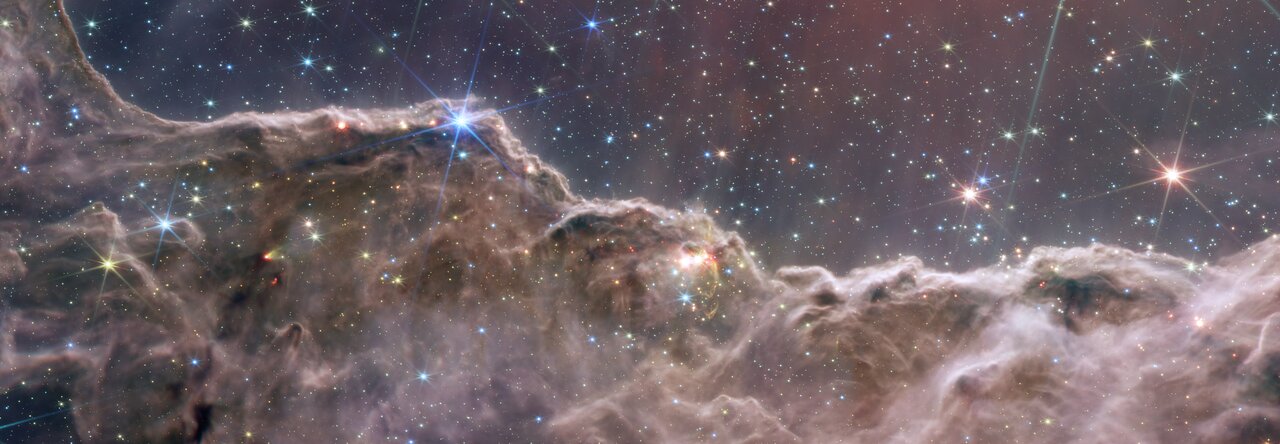About the Object
| Name: | Carina Nebula, NGC 3324 | |
|---|---|---|
| Distance: |
7600 light years | |
| Constellation: | Carina | |
| Category: | First Images MIRI Nebulae NIRCam | |
Coordinates
| Position (RA): | 10 36 54.35 |
|---|---|
| Position (Dec): | -58° 37' 18.05" |
| Field of view: | 5.63 x 1.95 arcminutes |
| Orientation: | North is 117.8° right of vertical |
Colours & filters
| Band | Wavelength | Telescope |
|---|---|---|
| Infrared | 7.7 μm | James Webb Space Telescope MIRI |
| Optical | 900 nm | James Webb Space Telescope NIRCam |
| Infrared | 11 μm | James Webb Space Telescope MIRI |
| Infrared | 2.0 μm | James Webb Space Telescope NIRCam |
| Infrared | 12 μm | James Webb Space Telescope MIRI |
| Infrared | 4.44 μm | James Webb Space Telescope NIRCam |
| Infrared | 18 μm | James Webb Space Telescope MIRI |
Combined NIRCam and MIRI Image of the “Cosmic Cliffs” in Carina
Astronomers using the NASA/ESA/CSA James Webb Space Telescope combined the capabilities of the telescope’s two cameras to create a never-before-seen view of a star-forming region in the Carina Nebula. Captured in infrared light by the Near-Infrared Camera (NIRCam) and Mid-Infrared Instrument (MIRI), this combined image reveals previously invisible areas of star birth.
What looks much like craggy mountains on a moonlit evening is actually the edge of a nearby, young, star-forming region known as NGC 3324. Called the Cosmic Cliffs, this rim of a gigantic, gaseous cavity is roughly 7,600 light-years away.
The cavernous area has been carved from the nebula by the intense ultraviolet radiation and stellar winds from extremely massive, hot, young stars located in the centre of the bubble, above the area shown in this image. The high-energy radiation from these stars is sculpting the nebula’s wall by slowly eroding it away.
NIRCam – with its crisp resolution and unparalleled sensitivity – unveils hundreds of previously hidden stars, and even numerous background galaxies. In MIRI’s view, young stars and their dusty, planet-forming disks shine brightly in the mid-infrared, appearing pink and red. MIRI reveals structures that are embedded in the dust and uncovers the stellar sources of massive jets and outflows. With MIRI, the organic, soot-like material on the surface of the ridges glows, giving the appearance of jagged rocks.
Several prominent features in this image are described below.
- The faint “steam” that appears to rise from the celestial “mountains” is actually hot, ionised gas and hot dust streaming away from the nebula due to intense, ultraviolet radiation.
- Peaks and pillars rise above the glowing wall of gas, resisting the blistering ultraviolet radiation from the young stars.
- Bubbles and cavities are being blown by the intense radiation and stellar winds of newborn stars.
- Protostellar jets and outflows, which appear in gold, shoot from dust-enshrouded, nascent stars. MIRI uncovers the young, stellar sources producing these features. For example, a feature at left that looks like a comet with NIRCam is revealed with MIRI to be one cone of an outflow from a dust-enshrouded, newborn star.
- A “blow-out” erupts at the top-centre of the ridge, spewing material into the interstellar medium. MIRI sees through the dust to unveil the star responsible for this phenomenon.
- An unusual “arch,” looking like a bent-over cylinder, appears in all wavelengths shown here.
This period of very early star formation is difficult to capture because, for an individual star, it lasts only about 50,000 to 100,000 years – but Webb’s extreme sensitivity and exquisite spatial resolution have chronicled this rare event.
NGC 3324 was first catalogued by James Dunlop in 1826. Visible from the Southern Hemisphere, it is located at the northwest corner of the Carina Nebula (NGC 3372), which resides in the constellation Carina. The Carina Nebula is home to the Keyhole Nebula and the active, unstable supergiant star called Eta Carinae.
NIRCam was built by a team at the University of Arizona and Lockheed Martin’s Advanced Technology Center.
MIRI was developed as a partnership between NASA and ESA (European Space Agency), with NASA’s Jet Propulsion Laboratory leading the U.S. efforts and a multi-national consortium of European astronomical institutes contributing for ESA.
For a full array of Webb’s first images and spectra, including downloadable files, please visit: https://esawebb.org/initiatives/webbs-first-images/
Credit:NASA, ESA, CSA, and STScI
About the Image
| Id: | weic2205b | |
|---|---|---|
| Type: | Observation | |
| Release date: | 12 July 2022, 17:20 | |
| Related releases: | weic2205 | |
| Size: | 11264 x 3904 px | |




